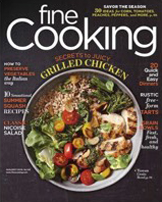
在我开始与超级巨星厨师托马斯·凯勒(Thomas Keller)合作之前,我从未考虑过釉面蔬菜Bouchoncookbook. Our editor suggested we do a short essay on the subject, so I got a lesson in glazing from the master himself in the French laundry kitchen. (How lucky is that?) Like most things that come out of his pristine kitchen, Thomas’s glazed vegetables were amazing—glossy, tender, and sweet but not cloying. They were an eye-opener. I’m sure I learned how to glaze vegetables in cooking school, but until my lesson with Thomas I had mostly experienced the dish as vegetables boiled with a heaping handful of sugar or sautéed in butter and sugar. At the French laundry, I realized that when glazed vegetables are done right, much of the sweetness comes from the vegetables themselves. As the vegetables cook, the liquid draws out their sugar and reduces to form a delicate glaze (with the aid of butter and just a touch of additional sweetener). That’s the alchemy Thomas showed me, and the method I still use.
用右锅和足够的水覆盖
使釉面蔬菜变得良好,始于选择一个足够宽的锅,可以贴合所有蔬菜在一层或多层中。您不希望它们散布在一个巨大的锅中。对于1磅的蔬菜,底座约8英寸的锅通常可以解决问题。我使用倾斜侧面的一个,因为它可以更容易地将蔬菜扔入釉中,但是直侧也可以。
While the right pan makes a difference, the real secret to making glazed vegetables turn out well is learning how much water to use. Adding too much can cause your vegetables to overcook by the time your glaze is formed. Adding too little, while less of a problem, can result in unevenly cooked vegetables. A good guideline for finding that middle ground is to add just enough water to cover the vegetables.
I’ve found that if I get all of the above right, the vegetables will finish cooking at the same time the glaze is formed, which is ideal. But sometimes things don’t work out that way, and that’s OK, too, because there’s some flexibility with this method. I always taste the vegetables after they’ve been boiling for about 10 minutes. If they’re cooked through but there’s still a lot of liquid in the pan, I remove them and let the liquid continue cooking until it’s syrupy, then add the vegetables back to the pan. If the glaze forms before the vegetables are cooked through, I just add a little more water and let them cook longer.
Listen for the crackle
我学到的另一个伟大的技巧是烹饪釉面蔬菜,是让釉告诉我何时完成。尖锐而疯狂的冒泡声,几乎是一种裂纹,意味着液体几乎消失了。这就是降低热量的信号。
知道要听什么,可以轻松将蔬菜釉在后燃烧器上,同时我将注意力转移到其他正在做饭的地方。
这可能是我从托马斯获得的最重要的教训 - 这不是在特殊场合保留的一些挑剔的技术。实际上,釉面蔬菜是一个很棒的工作日,因为它们很容易制作。您几乎可以独自留下蔬菜,然后偶尔摇晃锅煮沸。煮熟并形成釉料后,您就可以根据需要调味并提供调味料。
With this method in hand, you’ll find it’s simple to make shimmery, delicious, elegant glazed vegetables—even without Thomas Keller by your side.
尝试您最喜欢的口味
There’s a whole world of vegetables to be glazed, types of sweeteners to glaze them in, and flavors to add. Carrots are classic, but the technique works with any number of root vegetables (think beets, radishes, turnips, celery root, onions—the list goes on). Using honey, maple syrup, or brown sugar in place of granulated sugar is one way to change things up. Herbs, spices, and other flavorings add even more variation—curry, miso, cayenne, and balsamic vinegar are a few of my favorites, but there’s plenty of room to get creative.























注释
发表评论
注释